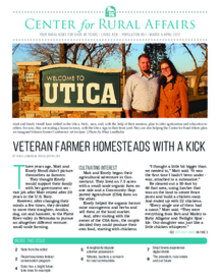Note from the Editor
Recently, we hosted “Vang: A Drama about Recent Immigrant Farmers,” a story of eight immigrants coming to the U.S. to find solace and a livelihood in farming.
The two actors illustrated stories that ring true throughout rural America. After, the audience participated in a panel discussion featuring four immigrants: two beginning farmers, a Center for Rural Affairs staff member, and a community leader. They told touching stories about their experiences, both positive and negative.
The Center for Rural Affairs works in rural communities, assisting immigrant entrepreneurs, community leaders and new farmers. We are proud of the work we do to help these individuals achieve the American dream.
This edition of our newsletter focuses on RESPONSIBILITY placed upon each of us to contribute to our community and society. Our responsibility lies in welcoming new Americans as they find success in their new home.
Our responsibilities continue with assisting beginning, veteran and socially-disadvantaged farmers gain access to land and information; encouraging renewable energy; urging developers to extend broadband internet into rural areas; and taking care of our water, acting as good stewards for future generations.
We also have a responsibility to vote, electing local, state and national officials; and we have a responsibility to keep those officials accountable to their constituents by letting them know about policies that we care about.
Want to get involved? Contact us at [email protected].
Inside this issue
Veteran farmer homesteads with a kick: Three years ago, Matt and Emely Hendl didn’t picture themselves as farmers. They thought Emely would support their family with her government service job after Matt retired after 20 years in the U.S. Navy. However, after changing their minds a few times, they decided to move their daughter, Annika, dog, cat and hamster, to the Platte River valley in Nebraska to pursue an altogether different venture: small-scale farming.
From the desk of the executive director: The president, rural voters and our future: Rural voters had a moment following last fall’s election. The national media showed up in force seeking to understand them. Enough rural voters had switched party allegiance to account for Trump’s victory over Clinton in several key Midwest and Rust Belt states.
Report examines federal conservation program: The Center for Rural Affairs recently released “Pathways to Land Access,” a report by Anna Johnson with support from Glen Ready. The paper is a study of the Conservation Reserve Program - Transition Incentives Program (CRP-TIP), administered by the U.S. Department of Agriculture, Farm Service Agency (USDA-FSA).
A neighborly dispute: Adverse Possession: Joe and Carol Schmieding’s property included a waterway and a driveway running along its east side. Land east of the parcel sold in 2001. The exact location of the property line was not determined, so the couple and their new neighbors agreed to share the driveway. Five years later, Joe discovered a survey marker that marked the boundary line. However, when Joe prepared to modify the driveway and waterway in 2010, the neighbors sued for adverse possession.
Nitrate, bacteria a concern for rural communities: Amid growing public awareness, rural residents are becoming more well-versed on water quality challenges. Nutrients, bacteria and sediment levels in surface waters endanger human health, wildlife habitat and outdoor recreation.
Solar has a bright future; take Iowa for example: The solar energy industry is poised for explosive growth over the next decade and has potential to bring massive economic and environmental benefits to rural Americans. Learn about these benefits and how you can help create a strong foundation for this emerging market.
Broadband can bridge the digital divide: Access to the internet. The internet is now considered a basic human right; it is how people find employment, handle their finances, receive an education, work, and receive medical care. However, not everyone is able to use the internet to its full potential, due primarily to slow speeds. Rural areas are at a disadvantage when it comes to accessing broadband.


